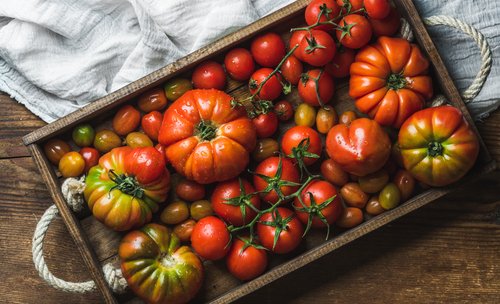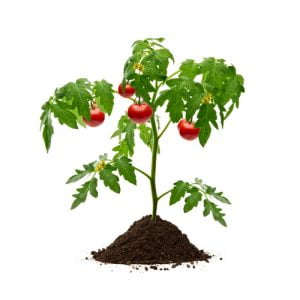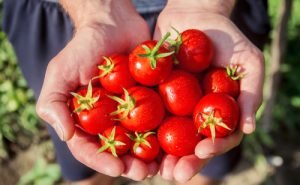
The origins of the tomato
I would guess a good many of us know the answer to the age-old question surrounding the tomato on whether it’s a fruit or vegetable?

The tomato plant, Solanum Lycopersicum, is a type of nightshade
Botanically speaking
Botanically speaking, the tomato is classified as a fruit because it has seeds. As with other fruits, tomatoes are formed from the plant’s flowers, that have seeds, and assist with the plant’s reproduction process. The only reason a tomato has only ever been thought of as a vegetable is because of its culinary use. Unlike most fruit, the tomato is much more savoury than sweet, which tends to make it highly versatile as a constituent in cooking. Thus, gastronomical at least, the tomato tends to be treated like a vegetable in as much as it is mostly used in main-courses rather than desserts. The tomato, being highly prevalent in most cuisines across the world is the most abundantly used fruit throughout the world.
Solanum Lycopersicum, commonly known as a tomato plant, like the potato, is a perennial and member of the nightshade family. The species originates from South and Central America, although there are some pundits who specifically claim it comes from Mexico. The Aztec word ‘tomatl’ gave rise to the Spanish word ‘tomate’, from which the English word ‘tomato’ was derived. The Aztecs were using tomatoes in their cooking at the time of the Spanish conquest in the 16th century. The Spanish then brought the plant to Europe from where the tomato was introduced to all parts of the European colonised world.
Varieties
There are some 7,000 to 10,000 varieties of the tomatoes, which are widely grown across the world. In temperate climates, the use of greenhouses allows for a long growing season. Plants usually grow to between 1–3 metre in height, but their sprawling vines have a weak stem, that typically needs support. Indeterminate tomato plants are perennials in their native climate but are cultivated as annuals in temperate zones. Determinate (bush) plants are annuals that stop growing at a certain height, producing a crop all at once. Based on their shape and size, tomatoes are generally classified as being one of eight categories. These are beefsteak, plum, cherry, grape, campari, tomberry, oxheart pear or globe. However, other for tomatoes classifications do exist.
Cultivation
In the UK tomatoes are usually grown in greenhouses but it is possible to grow them outside in mild, sheltered locations. The use of protective frames or cloches also makes it possible to grow them even where some weather conditions may not be ideal. And, if you don’t have much space available, you could also choose to grow the many available varieties of dwarf or cherry tomatoes in hanging baskets, window boxes or patio pots. Tomato plants can be grown from seed, or if you don’t want the hassle, you could just purchase the plants from a dependable nursery or garden centre.
There are many varieties of tomatoes, most of which are of the vine (aka cordon or indeterminate) type, which require supporting and *side-shooting, whether they are grown in a greenhouse or outside. Bush (determinate) types of tomato are less common but easier to look after, since they do not require staking and trimming, and are only grown outdoors. Both vine tomatoes, whether grown inside or outside and bush tomatoes, will usually crop over a long period.
Growing plants from seed
You can begin to grow certain types of tomato plants from seed as early as mid-February, but you will need a heated greenhouse capable of maintaining a constant temperature at 18 deg C (65 deg F). The seedlings will take about 8 weeks to develop to a stage where they can be planted. It is also quite possible to grow tomatoes from seed in an unheated greenhouse, once there is no further risk of frost. While there are some minor variations on the method of growing tomato plants from seed, the following is one of the simplest:

- Fill compostable seed pots with compost and place in a tray. This will make re-potting at a later date easier and dispenses with the use of any plastic.
- Gently push 2 or 3 seeds into each pot and cover with a thin layer of compost about ¼” (6 mm) thick, then lightly water the surface.
- Cover the seed tray with a lid (normally glass or plastic) and place in a heated greenhouse, or alternatively on a sunny windowsill, to aid germination.
- Once the seeds have germinated remove the weakest seedlings to leave a single plant to grow into a baby tomato plant.
- When the tomato plants have grown to about 8” (200 mm) high, re-plant them into a ‘growbag’, covering the bottom 1/3 of the stem with compost.
- Add a bamboo cane (or similar) for support, tying the plant loosely to the cane with string.
- Water the tomato plants on a daily basis, in either the morning or evening, when temperatures are low.
- Once a plant has flowered, apply a teaspoonful of specialised tomato feed, watered into the soil surface, on a weekly basis.
Harvesting
Those varieties of tomato that grow readily in a greenhouse, where there’s been plenty of sunshine leading up to summer, should ripen as early as mid-June. The same varieties should ripen about a month later if planted outdoors. Almost all types of tomato have a long cropping season and it should be possible to harvest fruit through to October.

Leave a short piece of the stem when picking
Tomatoes should be picked individually when they are fully coloured all over, i.e. they have ripened. To maintain freshness and taste, its best to break off the fruit with a shot piece of stem. Handle gently, as the skin of tomatoes can be bruised very easily. If you find some fruit seems reluctant to fully ripen and marred by yellow patches, it is most likely due to insufficient potash in the soil. You can avoid this yellowing happening by working a good source of potash into the surface of the soil before planting. Nitrate of Potash (Saltpetre) and Sulphate of Potash can be applied to topsoil in dry or liquid form. Other good sources of potash include Seaweed Ash and Wood Ash, the latter usually being the cheapest available source.
Late in the season, when it becomes obvious that the last of the tomato crop is unlikely to fully ripen in the open, they should then be picked. The fruit then placed in a sunny window of a warm room to complete the ripening. However, a kitchen cupboard or drawer will work almost as well, since it’s temperature, not sunlight that is the essential element for ripening. If there’s some fruit that still refuses to ripen, you could always make yourself a few jars of chutney.
Common diseases
Septoria
Septoria disease manifests itself as green-black spots on foliage, which then dies and rolls up. However, stems and fruit can also be affected. To counteract the disease, spray plant with a Bordeaux mixture (or similar) immediately symptoms become apparent, which would normally not be before June. Badly affected plants should be removed and burnt.
Root Knot
The root-knot disease is first indicated by drooping of the foliage, which ten yellows. This is followed by the stem becoming limp and the plant eventually collapses. Minute eelworms in the roots of the plant are the cause. To overcome the problem, uproot the plant and burn off-site, treating the soil with quicklime before reuse.
Sleepy Disease
The first sign of the sleepy disease is when the plant leaves to begin to droop. A little later, mildew will begin to appear on the lower part of the stems. As for root-knot, uproot the plant and burn off-site, treating the soil with quicklime before reuse.
Tomato Blight
Tomato blight is one of the main diseases that attack plants grown outdoors. It’s exactly the same disease that attacks potato plants, appearing as brown blotches on the upper surface of the leaves. Blight can sometimes be treated by spraying with a suitable fungicide, but should not generally be used when the fruit is close to ripening.
Leaf Rust
There are various forms of leaf rust, but if left unchecked, they can all result in leaves rolling-up and dying. However, if caught early enough, it can be prevented from spreading by dusting healthy leaves with ‘flowers of sulphur’, and removing the diseased leaves. An airy, well laid-out greenhouse, with plenty of light and good plant spacing, should greatly help to mitigate the problem.
Popular varieties:
- Tumbling Tom – a great variety of determinate plant, ideal for growing in hanging baskets or other containers, as well as the greenhouse. The plants remain compact and should produce a mass of small, sweet tomatoes.
- Gardener’s Delight – a classic, easy-to-grow, determinate variety of cherry tomato that produces sweet, juicy fruit.
- Ailsa Craig – commonly grown indeterminate variety of tomato that usually produces great yields of medium-sized fruit with an outstanding taste.
- Marmande – a semi-determinate and type of beefsteak tomato that produces great tasting, early, large fruits, that contain few seeds.
NB: *early removal of side shoots in order to maintain a single stem.
References to months and seasons for planting and harvesting are those particular to the UK.
If you’ve enjoyed reading this article, why not click on the link to Hobbies and Pastimes, to see if there’s anything else that takes your interest?





